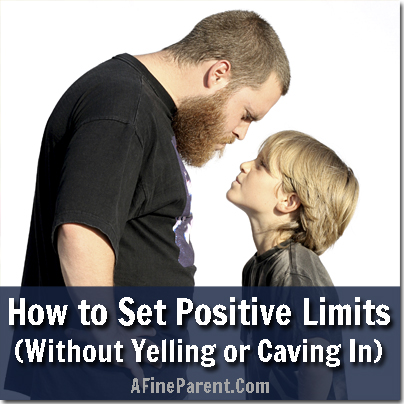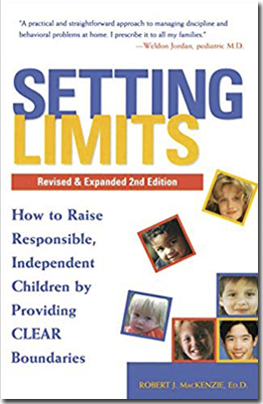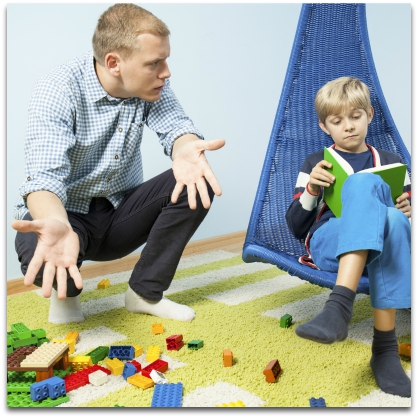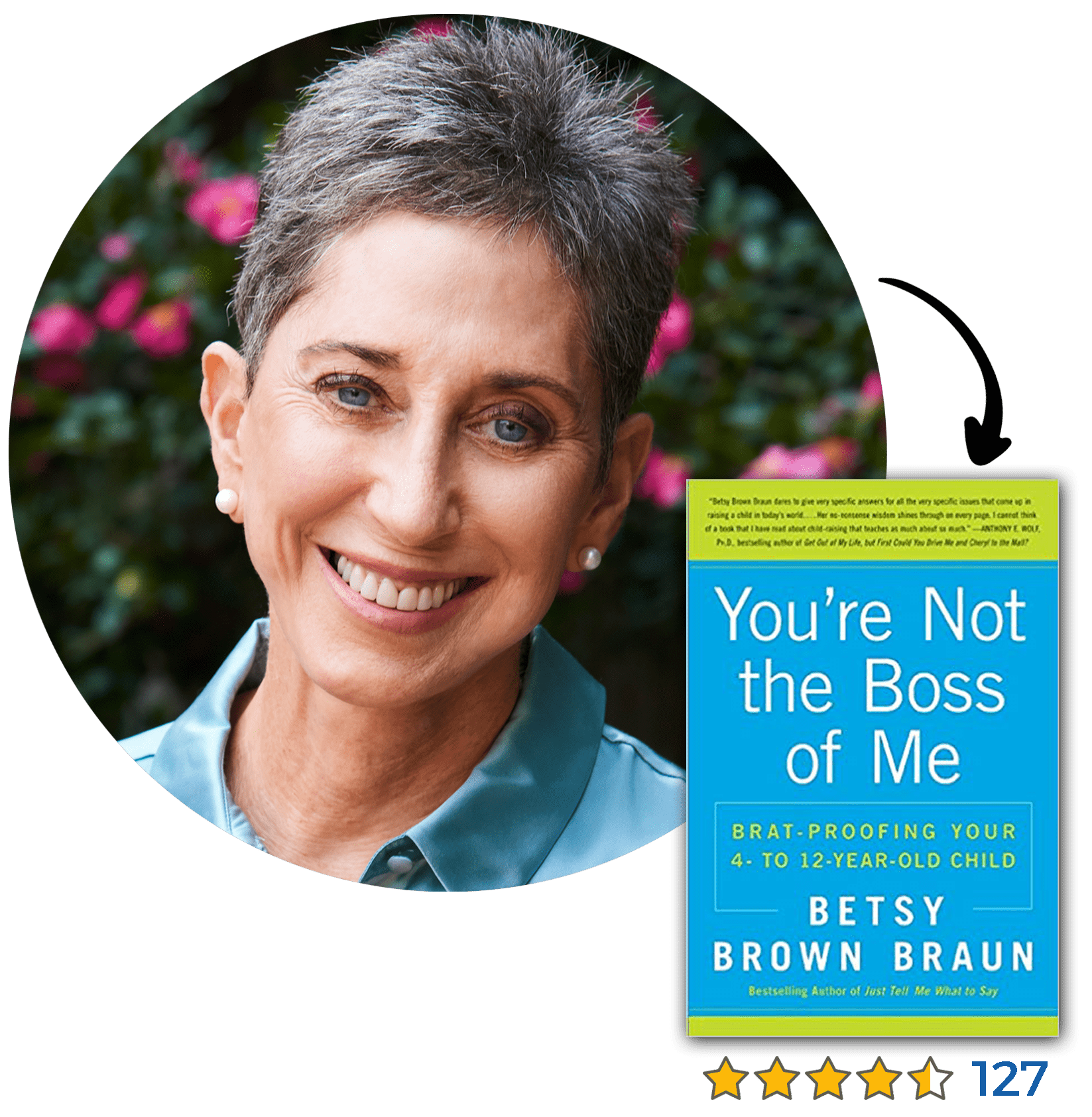 It’s time to leave the park, but your kid isn’t ready.
It’s time to leave the park, but your kid isn’t ready.
You’re already running late for dinner, but he’s having a great time. You don’t want to end on a bad note, do you?
So you agree to give him a few more minutes. Then you sweetly let him know it’s really time to go.
He drags his feet. He pouts. You feel the tension building up.
You did everything right. You gave advance warning, you talked positively. What now? How are you supposed to set limits without yelling or caving in?
Why is Setting Limits So Important?
 Before we figure out how to set limits, let’s quickly review what they are. A limit is your way of teaching your child what she is and isn’t allowed to do.
Before we figure out how to set limits, let’s quickly review what they are. A limit is your way of teaching your child what she is and isn’t allowed to do.
In the book Setting Limits: How to Raise Responsible, Independent Children by Providing Clear Boundaries, author Robert J. MacKenzie explains that kids have an important job: to discover how the world works. They need to learn how far they can push you and what happens if they overstep.
Your job as a parent is to set limits, and to coach your kid so she’s able to stay within them.
Through limits, your kid learns self-regulation skills so he can make good choices in the wider world. He also learns about healthy relationships, and that he needs to take others’ needs into account when he makes his choices.
Limits also keep kids healthy and safe. Let’s face it, if we parents weren’t there to limit where our kids go and what they eat, what do you think they’d do all day? Probably play in the street and be eating chocolate for breakfast, lunch and dinner!
That’s not all, though. Children actually need limits to feel secure. That’s one reason why kids test limits – so they’re reassured that the limits are there.
Realities of Setting Limits
 Sometimes, setting limits is easy. You let your child know what the limit is and he sticks to it.
Sometimes, setting limits is easy. You let your child know what the limit is and he sticks to it.
The trouble is when your child ignores directions and violates the limit. And when you redirect him, he throws a tantrum, accuses you of being a bad parent, or just flat out ignores you.
What do you do then? Nag? Shout? Drop the limit altogether?
If you allow your child to take on all the power in your relationship, you’re in for a rough time. Your kid won’t learn how to respect limits and will struggle when he interacts with the wider world.
And you’ll find it incredibly stressful to function when your kid always gets final say in pretty much everything.
But how do you set limits? Are punishment and rewards the answer?
The Trouble with Traditional Limit-Setting
When my daughter was two and a half, I decided it was time to potty train. I did everything right. I read all the potty training books in my local library, and bought a few for good measure. I got a doll to model with and prizes and treats as rewards.
My daughter loved the attention and the rewards. But once I started scaling back, she started wetting.
Help! That was not supposed to happen.
So I switched to using a potty chart instead. And she figured out that as long as she sat on the toilet regularly, she’d get her prize – whether or not she actually stayed dry.
Well, if rewards didn’t work, maybe it was time to try some punishments. (Cringe-worthy, I know. But I was too busy reading potty training books to brush up on my positive parenting techniques.)
Anyway, time-out didn’t work. Nor did insisting that she clean up the mess.
In hindsight? She just wasn’t ready. Three months later, I gave up and put her into Pull-Ups. She wound up trained after her third birthday.
That’s the trouble with traditional limit-setting. It ignores the reasons why most kids misbehave.
Why Kids Violate Limits
 Kids want to make the right choices. They want to stick to your limits. If they don’t, it’s because:
Kids want to make the right choices. They want to stick to your limits. If they don’t, it’s because:
- They don’t have the skills they need, or
- They feel a weak connection to you, and so they don’t feel the need to follow your limits, or
- They’re feeling hurt and angry, and this is their way of working through those feelings.
Punishment and reward are actually very similar. They both work to control your kid’s behavior, rather than teaching your kid to control her own behavior.
 Have you ever questioned why your child is acting like… well, a brat? You’re not alone! We partnered with Betsy Brown Braun, child development and behavior specialist, author, and founder of Parenting Pathways, Inc., to explore the motivation behind behavior and the idea that focusing on communication with our child can help with “bratty” behavior.
Have you ever questioned why your child is acting like… well, a brat? You’re not alone! We partnered with Betsy Brown Braun, child development and behavior specialist, author, and founder of Parenting Pathways, Inc., to explore the motivation behind behavior and the idea that focusing on communication with our child can help with “bratty” behavior.
This packed masterclass is one of the 70+ masterclasses you get when you join the AFineParent Academy today. Click here to learn more.
By doing that, you rob your child of his intrinsic motivation to choose correctly. You actually make it less likely that he’ll make the right choice next time – and you’ll be stuck stepping in yet again.
Your goal is to be the coach rather than the cop.
You don’t want to be correcting her behavior forever. Instead, you want to help her build up her own self-regulation skills.
But how are you supposed to do that?
#1 Set Your Limits Right
 The first step is to set clear and consistent limits.
The first step is to set clear and consistent limits.
You need to make sure that your child knows what the rules are, and is on board with following them.
The easiest way to create rules is actually to brainstorm together with your child. When kids are involved in the process, they’re much more likely to cooperate.
Like we mentioned, kids intrinsically want to do the right thing. You’ll be surprised at what they can come up with.
Distill their ideas (and yours) into three to five rules, and write them down to make them concrete. Then, discuss the rules and explore what the values are behind the rules. Let your child know that he needs to follow the spirit of the rule, not just the letter of the rule.
Now, note that consistency doesn’t mean you can’t make exceptions to the rule. If you’re at a party with your kids, that might be a good time to allow them to eat dessert before the main course. Just make sure your child understands why you’re doing things differently and that your usual rules haven’t changed.
Kids will learn flexibility and critical thinking skills if you talk through your reasoning.
#2 When Your Child Crosses a Limit
 You can have the best family rules ever, but at some point your child will violate them.
You can have the best family rules ever, but at some point your child will violate them.
That’s okay! Kids are supposed to test limits. Remember, that’s part of a child’s job.
So what do you do now?
The first step is to gently redirect. Let your kid know, “Remember, our rule is that we do homework before we go outside. It’s time to do your homework now.”
What if he still doesn’t obey? Then you’ll need to get physical to make sure that he does.
You aren’t punishing your child. You aren’t getting rough with him. Just gently hold him by the hand or the shoulder so he knows that he can’t just ignore you.
So he knows you mean business.
 Patty Wipfler’s book Listen gives some great tips on how to peacefully set a limit:
Patty Wipfler’s book Listen gives some great tips on how to peacefully set a limit:
- Take a few moments and find your inner calm. Is your child’s behavior tensing you up? Do a little slow breathing. You need to find your inner peace so you can work with her peacefully.
- Get down to your child’s eye level and gently ask what’s going on. Listen to her take on the situation, and empathize with her.
- Calmly state the limit and use touch to make sure she listens and obeys.
Actions speak louder than words. And kids learn from what you do, not from what they’re told.
#3 Let Your Child Cry, It’s Okay
 What if your child starts crying? Does a Fine Parent let their kid cry?
What if your child starts crying? Does a Fine Parent let their kid cry?
Dr. Laura Markham, in her book Peaceful Parents, Happy Siblings, is very emphatic. It’s okay for kids to cry sometimes. Their tears are a sign of grief, and grief is what helps them learn to make better choices next time.
And Patty Wipfler says that when your child cries, he’s releasing the hurt and angry feelings that led him to violate your limit. Those tears can actually help to heal your relationship with your child.
Instead of working to stop the crying, show your child empathy. Let him know that you feel his pain and you’re here for him. This helps him learn to regulate his own emotions.
Give her time. She might need a long crying jag to recover from her overwhelm and whatever hurt is swimming through her.
After she calms down, help her come up with a plan for the future. What was it that led her to violate your boundaries today? How can she regulate herself next time? Get a commitment that she’ll follow the plan.
It’s true that kids hate bumping into your limits. But when you balance the limit-setting with listening and connection, limits actually become a positive thing. He knows that you said no but you care about him — or, maybe, you said no because you care about him.
So, the next time your child violates a limit, stop and breathe. That way, you’ll respond from a place of peace instead of anger.
Then make a mental note on when and how she violated the limit. You might even want to jot down a few notes. This will help you tweak your limits so your child is more likely to follow them.
The 2-Minute Action Plan for Fine Parents
Here are a few questions to think about:
- What limits do you have in your family? Do your kids know what they are?
- What do you do if your child violates a limit? Are you consistent about it?
- Is there a behavior that your child does often and you’re unhappy about? Do you have a limit around that behavior? If not, do you want to create one? If you do, can you tweak the consequence to make sure it’s achieving your goal of coaching your child rather than punishing him?
The Ongoing Action Plan for Fine Parents
- Create a family meeting, involving every family member if possible. Ask everyone what rules they think already exist in your family as well as what rules are necessary. Distill everyone’s ideas into 3-5 rules.
- Continue to practice peaceful limit-setting. Old habits die hard, and most of us are used to either yelling or caving in. Work to train yourself to take a few deep breaths and respond peacefully and firmly.
- Notice what happens after your child cries. Does your relationship grow stronger? If so, you’ll find it easier to hold firm the next time.
great work
Great Work.
“Very practical and useful tips! Establishing a good morning routine makes a big difference for young children. Thank you for sharing such helpful insights.”
Its Very Interesting Book .It as good points.
Thank You !!
Setting limits is key to teaching kids responsibility and respect. Love the focus on positive parenting—excited to check out the free mini-course!
Quiet Interested!!
thank you for this great article
Great points. I never heard of the term positive limits but it makes a lot of sense. I always disliked rules as a child but once I understood the reasons behind the rules, I could abide by them if the made sense to me.
I actually have the Peaceful Parenting Book and it helped me a lot when I was struggling as a Single mom with a little one on my own. I was exhausted and he would act out and I started getting frustrated with him because he was not telling me or knowing how to express himself to me. This book has so much great information and examples as well as tips on how to do in step by step. I love it.
Your story about how you discovered that your attempts to “help your child be more outgoing” were actually attempts to make him like things that you liked at his age really rings true for me!
Your story about how you discovered that your attempts to “help your child be more outgoing” were actually attempts to make him like things that you liked at his age really rings true for me! It’s hard to accept it when your kids don’t have the same passion for things that you find fascinating. Asking for help from others who might share personality traits or interests with your kid is a great suggestion! Thanks!
Amri, this is exactly how I got my students to create rules and follow them. As a special ed teacher I had many students who struggled to do what they were told. When they helped create the rules and took ownership of them, they policed themselves and each other. It’s so much easier to set limits when everyone’s on the same page. I’m glad you found it helpful!
And I also really like the concept of crying as a release of tension. It’s a huge relief to know that crying is often healthy! I learned about it from Patty Wipfler. She discusses it a lot on her site, handinhandparenting.org.
Also, Esty, thank you for this great article. I really liked the bit about involving the kids in the rule making and asking them what they think the rules are. For my older children (9 & 13) I would think it’s a lot harder to ignore the rules when you just mentioned aloud that you know what they are! The advice that crying can be healing and strengthen relationships was gold for me. I’d never really thought about that and have such a hard time when my oldest is so upset that she cries, but you bring up a good point. Those tears are a release and help you start fresh.
Thanks!
Hi I just wanted to chime in as well. For that age, modeling with stuffed animals or puppets can work really well. Find a time when she’s in a good mood and you’re playing and pretend that her toys kicked and hurt each other. Let “them” talk about how it hurt them physically and emotionally. Let them give better ideas of what to do when they’re angry.
I’m not much of a puppet person myself, but I tried this with my son when he was even older than your daughter and I was so surprised that what we went over with the puppets stuck in his mind. Way more than the million times I talked about it when he was upset or even calm. He mentioned it weeks later and showed much more empathy for me instead of violence after that.
Hi Diane. Thanks for your comment!
You’re right that a three-year-old will have less to contribute to a family meeting at first. You’ll have to coach her through it.
Find a time when you’re both feeling calm and connected with each other. Open with something like:
“I’ve been getting a lot of kicks lately. They really hurt. I don’t want to get kicked anymore. What should we do?”
She might shrug or answer, “I don’t know.” She also might say, “Well, you didn’t give me what I wanted!”
You’ll want to start giving her suggestions for what she can do instead (use her words, kick a beanbag).
And then set the limit. Let her know: “There are some things you can’t do, even if you’re upset. Kicking Mommy is something I can’t let you do. So if you try to kick Mommy, I will have to (walk away, hold you so you can’t kick me, or even lock myself in another room if necessary). ”
And if she kicks again (when she kicks again, if she’s anything like my kids!) follow through on the limit you discussed with her.
Later, after she’s calmed down, reconnect with her. Let her know that you still love her, even after she made a mistake and even after you had to set a limit.
Hope that helps! Let me know how it goes.
I love the idea of this, but my daughter is 3 1/2. I highly doubt I’ll be able to get a family meeting where she offers ideas of limit setting and what to do if she crosses a boundary. Even if I WERE able to do this (and I’m willing to try), I wish there were more “real life” examples to relate to in this article so I could get a better understanding of this thought process.
My child hits and kicks when she gets overwhelmed. She’s connected her foot to my chin more than once and I can’t help but get really angry. The last time this happened, I just did my best to compose in her presence and put her in bed and walked out of the room until I felt I could see her again. I’ve tried telling her how kicking hurts and I won’t let her hurt me. I’ve tried just being there quietly until she stops but she just doesn’t stop. She’s looking for a reaction as your article confirmed.
And then there is the even larger issue of “Mommy is the only person in the house allowed to help me with anything” which basically handicaps her dad because she throws huge fits when he tries to do anything. This is a huge issue because he’s the stay-at-home parent. It pulls us all apart because by the time my work day is over, he just needs his space and retreats. And if he TRIES to be a part of our games and fun in the evenings and ALL WEEKEND long, she yells at him to “go away”. I’m completely exhausted by Sunday night and usually end up getting really crabby because I’ve had no break myself for the weekend.
Anyhow, I really want to be successful at this, but I don’t know how to manage specific instances and there really isn’t enough out there to help me work through it all.
Hugs from one momma to another. I’m sure the owners of this site will respond with additional direct suggestions but I wanted to share a few things as well hopefully to encourage you. A few things that stuck out to me was the age of your daughter, I know each child is unique but that age to about 4 and half I saw an increase desire to be independent. You are correct that a family meeting might not initially seem successful, however it would be a shorter, more concrete shorter version of a family meeting, but I bet she will take to the event that we have an important meeting and YOU can be a part of it because we need some ideas from YOU . (you being your expert daughter). When the basics “hands are for helping, not hitting” is covered each time a meeting is held, it plants a seed and will stick. It won’t necessary stop the behavior all the time but it possibly could some of the time. When your child karate chops you in the chin, please give yourself permission to say “Ow, Mommy is hurt and feeling angry, I’m taking some space”. You don’t need to stay there bleeding out, if anything that seems pretty powerful “Wow if I beat up mommy she’ll give me the negative “attention” I want. Don’t get in your car and leave but it’s okay to take 10 -15 minutes to regroup, compose yourself and then respond and address the behavior. We are less likely to “react” when doing this. Another part that stuck out to me was the mommy/daddy dynamic you mentioned. It’s clear she wants your attention and doesn’t want to share it and wants daddy to hit the road in that moment. Just as daddy will need some time each day at some point when you get home to have even a half hour to be by himself, go for a walk alone or just have adult time. You need some transition time as well between work and going home. I think when children know they are going to have their “own” special time 1:1 and then in addition “family time” it’s a little easier to accept mommy needs a few minutes to wrap some things up and then she is yours for 20 minutes. And then now …. it’s Family time… we do something else together for 20 minutes. These are just some examples. I hope something in here will be helpful. You are a great mom, the fact you were invested in reading this and looking for ways to improve your daughter’s ability to self regulate emotions and improve joy overall means you care greatly! 🙂
I can relate to the issue of parent favoratism completely. It is SO exhausting. I dealt with this for two years. My husband could not do anything for my son. What wound up working (miraculously) for us was to not cave in when he said “daddy go away”. My husband had a hard time learning not to take it personally and to carry on cheerfully. It is not personal. Finally we stopped letting my son make these rules. We set up in advance which one of us would be hanging with him at what part of the day. When he cried and screamed about me going to do some “me” things his dad just sympathized with him, and repeated calmly that “Daddy is caring for you right now. You will be with mommy again in a little bit. Or, mommy wants to read for a little while. I am here with you until she’s done.” He cried and cried, got a lot of feeling out, and wound up having to be held and comforted for a long time. For the first two times. Only two times!! After that I think it sunk in that he did not have the power to demand which parent was with him. Now he has completely abandoned that line of attack. Like magic. I think that letting him express all that anger and sadness, not backing down just because he was losing it, and showing him that we have more control in our daily lives than we were taking before, helped to set the limit firmly and lovingly. Good luck mama!
I recommend buying the book “1-2-3 Magic” by Thomas Phelan. I have 6 kids ages 2-19 and the concepts still help me not put emotion into the things you don’t want them to do. You can still do all the positive parenting, but the kicks in the face and tantrums can be stopped completely with the magic of no emotion and just giving them a break. It’s hard for parents not to talk talk talk about things. But some personalities just really like to get attention any way they can (even if it’s negative) and if you change the dynamic and put it on the child if they want to continue with whatever activity is going on (or go to time out) they really learn to change their behavior. Anyways, it’s simple but more complex than I have time to write here. 😉 Good luck and you are doing great! Parenting is a process. No one does it perfect, but we can learn from each other and love our kids always through it all.